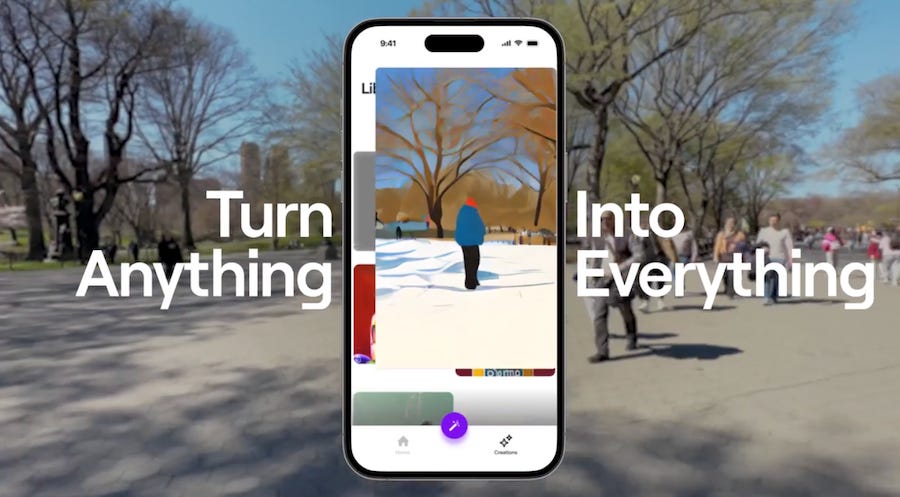Apple's Reality Distortion Field - Go Long on VR. Ignore Generative AI.
Hmm.....
[Steve] Jobs’s (in)famous ability to push people to do the impossible was dubbed by colleagues his Reality Distortion Field, after an episode of Star Trek in which aliens create a convincing alternative reality through sheer mental force. An early example was when Jobs was on the night shift at Atari and pushed Steve Wozniak to create a game called Breakout. Woz said it would take months, but Jobs stared at him and insisted he could do it in four days. Woz knew that was impossible, but he ended up doing it.
Walter Isaacson, the author of the definitive biography of Steve Jobs, wrote this passage for a Harvard Business Review article in 2012. He also wrote, “Because Jobs felt that life’s ordinary rules didn’t apply to him, he could inspire his team to change the course of computer history with a small fraction of the resources that Xerox or IBM had.”
The Reality Distortion Field, later known as RDF, was most often referenced in Job’s demands around product features and launch schedules. However, it also applied to markets. Many people were certain that the market sizes for iPods and iPhones were limited. Others were sure Jobs could never get music executives to go along with his iTunes scheme. He proved everyone wrong. RDF enabled him and others to see a future that was different from conventional wisdom and make it an undistorted and very real reality.
Apple’s new Vision Pro VR headset looks impressive. However, it takes a Reality Distortion Field to see this as a product blockbuster anytime soon.
It’s a Spatial Computing Device!
Apple executives are no fools. They understand that VR headsets have a “mixed reality” 😅 of achievement and little success to point to s far. They also have seen interest plummet in the metaverse. So, Apple didn’t launch a VR headset or onramp to the metaverse. Apple introduced a spatial computing device.
The LinkedIn post embedded above caused a nice round of discussion.
You can see in the comments some optimists, some pessimists, and some bewildered. I am in one of the latter two camps 🤔. I may have given Apple the benefit of the doubt a few years ago. A string of hits like the iPod, iPhone, iPad, MacBook Air, Siri, Apple Watch, and AirPods should not be ignored. That is such a long culture of innovation that two of those hit products came after Steve Jobs passed away.
However, VR seems like a demand-limited or utility-limited market as opposed to a technology-limited market in need of rescuing by Apple. What is the killer app for VR? For spatial computing, it is self-driving cars. Gaming seems like the obvious candidate for VR, but will it drive mass adoption?
Adam Cheyer, a co-founder of Siri, weighed in with his assessment. He sees VR and devices such as the Apple Vision Pro as a new computing user interface. By his calculation, it should arrive in mainstream use by … 2035. That is not soon. But, let’s face it, this may all move faster than it appears right now. Generative AI and large language model innovation seemed to move slowly for years and then, all of the sudden, things came together quickly.
There is an interesting generative AI angle that might make VR more personalized, more immersive, and more differentiated than other product categories. However, there was no mention of this topic in the annoucement. It’s not on the radar. Note that this is a product planned for launch in early 2024. Apple could add LLM technology before the launch, but right now generative AI is not on the feature list for a product that is more than six months away from shipping.
No Mention of Generative AI
Everyone seems to be talking about generative AI except for Apple. That is not necessarily a mistake. Wired’s Khari Johnson reported today:
Matt Turck, an investor at FirstMark Capital, a firm that invests in a number of startups using generative AI in their products, calls the lack of generative AI talk a savvy marketing choice by Apple. Several AI-powered features got announced, but the lack of generative AI mention gave Vision Pro more of the limelight. “The reality is that Apple is a bit behind others like Microsoft and Google in generative AI, so it smartly chose to position itself as running its own race in AI, as opposed to trying to play catch-up with others,” he said in a direct message.
There was no reason for Apple to talk about genertive AI just to get into the conversation around the hottest technology trend. If they don’t have something interesting to say or introduce, being silent is a logical choice.
However, Peachy-Jean Retizos asked the 100 million daily active user question: When is the Siri update? There was no mention of Siri in the Vision Pro discussion. The demos reminded me of a Magic Leap product launch with gestures everywhere and no voice control. Surely voice interactivity is going to be an important UI affordance.
Siri also is widely viewed as the weakest of the leading voice assistants. It could benefit the most from an LLM upgrade. Yet Apple offered us nothing along these lines. Amazon and Google will have generative AI features for Alexa and the Assistant, respectively, in 2023. Will Apple do the same with Siri? Not likely.
Apple is a hardware company. It makes money selling devices and a bit more from applications and services running on those devices. Once Apple figures out how generative AI can help it sell more devices and retain users, it will commit fully ot the features. Until then, we are going to see more device launches with no mention of generative AI.
The other key takeaway is that Apple shows not everyone is talking about and implementing generative AI. It is not everything going on right now. However, it is the technology that is causing the most disruption and interest in new products. Apple is focused much more on incremental gains, and its disruption days are in the past.
Google Bard is Multimodal and Local - Is This a Sign of a Comeback?
Google Bard had an unimpressive debut in its February 2023 preview. The primary issue it faced was expectations. ChatGPT set a high bar. Google has a reputation for impressive demonstrations of its own in other areas. It also had been working on large language models (LLM) for many years, had a beta in limited circulation using the LaMDA LLM, and had to…
Runway Just Netted $100 Million and a Big Valuation from Google and Others
Insider reported this week that the generative AI video app Runway closed a $100 million funding round at a $1.5 billion valuation. The Information added that Google is a key investor in the round. The investment, part of a roughly $100 million funding round, underscores the fierce competition among cloud providers to get close to companies with cutting-…










